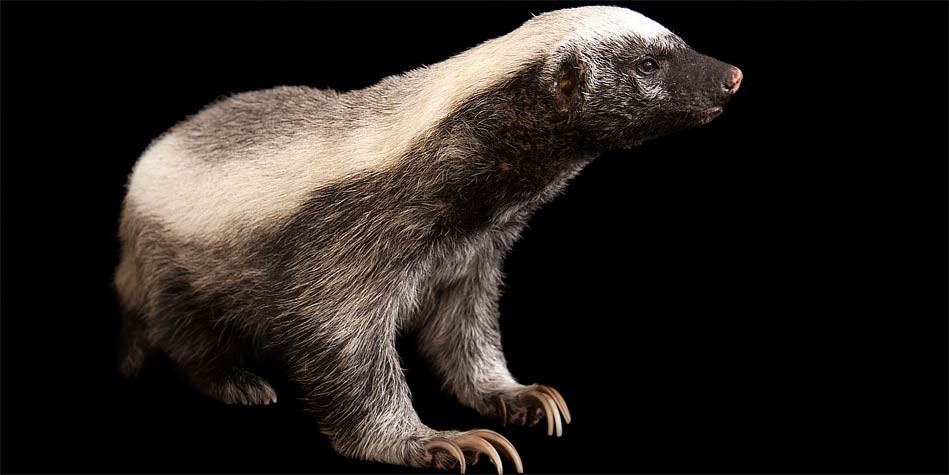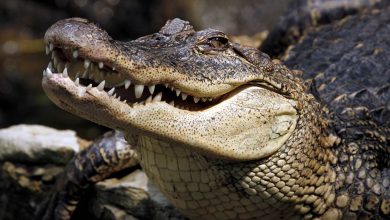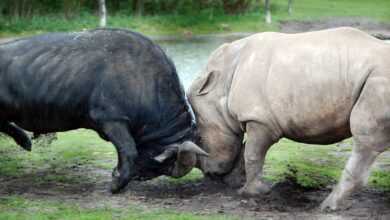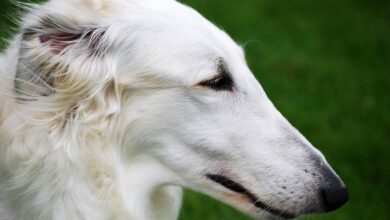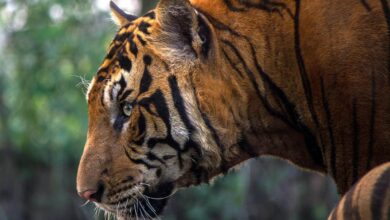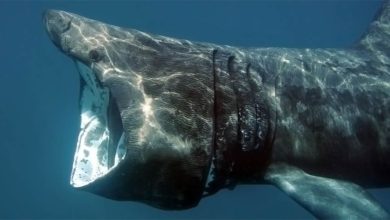The ratel, the honey badger (Mellivora capensis)
The most fearless animal in the world
The honey badger is an amazing animal not only because it likes honey. This animal, despite not being too big, fears other predators in Africa – cobras and even lions. What is the reason for its strength? How does it manage with the most aggressive hunters in the world during the attack? These questions and a few more will be answered in this article.
Classification
- Kingdom: Animalia
- Class: Mammalia
- Order: Carnivora
- Family: Mustelidae
- Subfamily: Mellivorinae
- Genus: Mellivora
- Species: Mellivora capensis
There are 12 subspecies among the species. They are distinguished according to differences in the size and the marking.
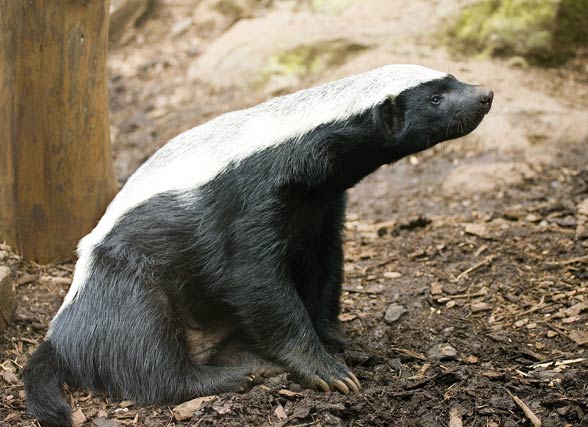
Subspecies
- Arabian ratel (Mellivora capensis pumilio) – Arabia
- Black ratel (Mellivora capensis cottoni) – Ghana, Congo
- Cape ratel (Mellivora capensis capensis) – South and southwestern Africa
- Ethiopian ratel (Mellivora capensis abyssinica) – Ethiopia
- Indian ratel (Mellivora capensis indica) – Asia
- Kenyan ratel (Mellivora capensis maxwelli) – Kenya
- Lake Chad ratel (Mellivora capensis concisa) – Sahel, Sudan
- Nepalese ratel (Mellivora capensis inaurita) – Nepal
- Persian ratel (Mellivora capensis wilsoni) – Iran, Iraq
- Speckled ratel (Mellivora capensis signata) – Sierra Leone
- Turkmenian ratel (Mellivora capensis buechneri) – Turkmenistan
- White-backed ratel (Mellivora capensis leuconota) – West Africa, Morocco, Congo
Distribution:
Most subspecies exist in Subsaharan Africa but some of them are also seen beyond the black continent: in Iran and Arabian Peninsula, as well as from Turkmenistan to Indian Peninsula. It is also known that they prefer heights up to 2,600 m (8,500 ft ) above the ground in Moroccan Grand Atlas Mountains and even up to 4,000 m (13,000ft) above the ground on Abyssinian Highland.
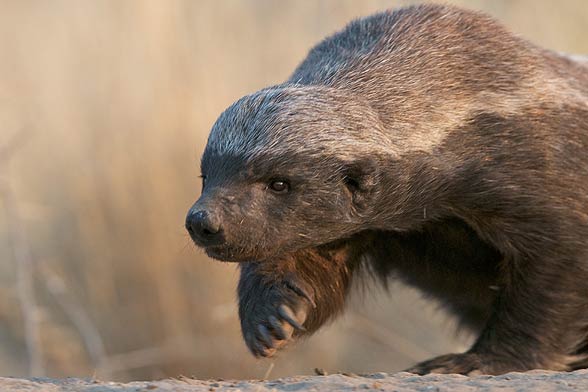
Characteristics
Appearance
Its characteristic feature is its longer body but it is relatively wide. Its head is quite small and at the end of it, there is a short mouth; at the top, it is flattened and its shape is similar to the badger’s head. The animal has got small eyes and ears which are really hard to be spotted and they are rather similar to small ridges. It is probable that this adaptation is to avoid damage while fighting with the opponent.
Skin
The other element of defense is very loose skin (developed adipose tissue under the skin) thanks to which the ratel can turn freely. The skin on its neck is about 6 mm (0.24 in) thick and it has been adapted to fight representatives of the same species. The skin on its back is thick and stiff which is the shield against bites and other predators.

Legs
The body is held on short but sturdy legs having five toes on each foot. Every finger has got the sharp and hard claws. Claws are very short on hind legs but on the forelimbs, they are extremely long. It moves on its paws (moving on the whole feet and hands’ soles) which are covered with soft but thick skin.
Marking
The body has got a short tail which is covered with long hair. The sides of its head and its bottom has got black hair, the dorsum from the tail till the head is white; despite the subspecies Mellivora capensis cottoni which has got plain black marking.
Size
Adult species are 23-28 cm (9-11 in) high at shoulders on average and 55-77 cm (22-30 in) long without the tail which is 12-30 cm (4.7–11.8 in). Males weigh 9-16 kg (20-35 lb) and females 5-10 kg (11-22 lb). Females are smaller than males concerning the size and the weight.
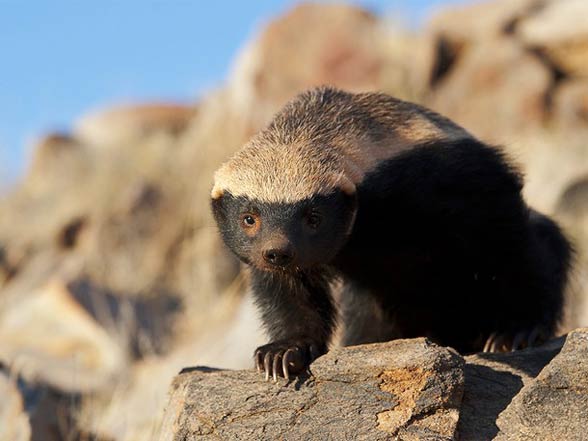
Diet
Similarly to wolverines, the honey badger is not really picky about food. This is a distinguishing feature from other weasel animals. In undeveloped areas, it hunts during the day but in places with high population, they prefer scavenging at night.
Its name is not accidental – honey badgers favour honey. It searches for hives for most of the time. Apart from sweet gold honey, it also likes meat; it would eat a frog, a rodent, a lizard, a snake, a bird or an insect. It sometimes eats eggs. The ratel can also try plants, both fruits and vegetables (fruits, bulbs, roots). It can kill a big and dangerous snake, e.g. a cobra and even the black mamba.
Its digestive system is almost every part of its body (just as Rambo’s :))- hair, feathers, bones and blood. It appears to be an intelligent animal – it lifts stones or tears off the bark of the tree.
Ratels are responsible for most incidents connected with digging out humans’ bodies out of Indian burial sites.

Lifestyle, disposition
Loner by choice
The ratel is all year round loner except for May when there is the reproductive season. At that time, everybody can see honey badgers hunting in pairs. However, little is known about its reproduction but it is estimated that the pregnancy can be about 6 months and after this period, two blind twins are born. It is hard to say how long ratels live. On the basis of observations in captivity, it has been stated that they live up to 24 years but nothing is known about its lifetime in wild.
Burrow
As we have already mentioned, the honey badger is usually solitary. It stays in the burrow which it dug itself; although some species prefer ready holes and they choose abandoned termites’ mounds or the aardvark’s dens. Thanks to strong claws, similar to those of moles, it can dig the tunnel during 10 minutes in hard soil. The burrow usually consists of one, 1-3 meter (3-10 ft) tunnel with the den at the end.

The bravest animal in the world
Its character is close to the wolverine and the badger – it shows the persistence and the endurance, but also the brutality. The ratel is thrusting and brutal; it can attack almost every creation; when it is attacked by a bigger opponent (even a lion) and it cannot escape, it can defend itself.
Bees are not able to sting it, the porcupine cannot sting it as the ratel’s skin is very thick. It is so brave that it attacks horses, the cattle and even the African buffalo if it intrudes upon its burrow. During the fight, it is fearless and fiery; therefore, not many big predators are courageous enough to hunt for it.
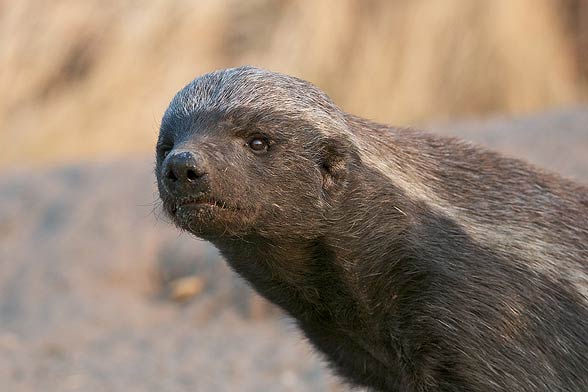
Similar to the skunk?
Similarly to mongooses or hyenas, the honey badger has got an anal pouch which extracts the suffocating smell. Probably, this mucus helps to calm bees when the ratel wants to obtain some honey. However, it is also used as the protection tool- in case of danger, it injects the smelly mucus towards its aggressor which deters it.
Relations with humans
Honey badgers often hunt for the poultry and because of its tenacity and aggressiveness, it is impossible to prevent such situations. Even a solid henhouse will not help. This predatory animal can destroy even thick wood boards.
A big dog will not help either – because the honey badger has got a thick skin and it is a tough animal, so killing it is a real challenge. Even if the dog grabs it on its neck, the ratel can turn around really quickly leaving a thick piece of skin in dog’s mouth. The thick skin can even resist the hit of the machete; therefore, the most effective way to kill the animal is hitting its head.
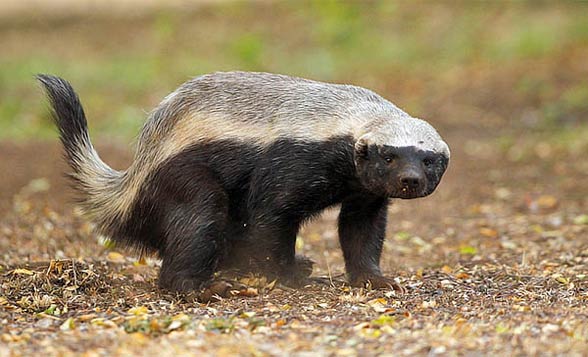
Detailed information and size:
The ratel/ the honey badger (Mellivora capensis)
- Body length without its tail: 55-77 cm (21.6-30 in)
- The length of the tail: 12-30 cm (4.7-12 in)
- Height: 23-28 cm (9-11 in)
- Weight: males: 9-16 kg (20-35 lb); females: 5-10 kg (11-22 lb)
- Lifetime: around 24 years in captivity

The ratel / the honey badger – interesting facts
- The ratel is the biggest land weasel animal in Africa.
- The braincase is wider than the dog’s one.
- It has been observed a few times that ratels can create and use tools which is the evidence for the high level of the intelligence.
- Unwillingness of most predators to hunt for the honey badger created the theory that the cheetah kittens have a similar marking to them to drive dangerous aggressors away.
- The honey badger can be resistant to the venom of many snakes. When it was bitten by the puff adder, it suffered from heavy pain but it recovered from it after about 5 hours (almost as Chuck Norris – we do not know what happened to the puff adder :))
- In Kenya, the honey badger is the main transmitter of the rabies.
- The ratel is placed in the Guinness Record Book as the most fearless animal in the world.
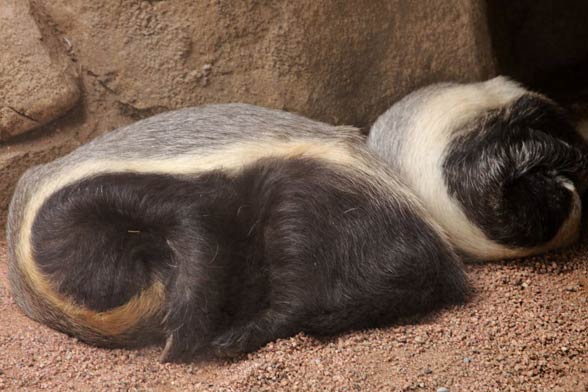
Recommended
- Persian leopard
- Amur leopard
- Siberian tiger
- Bengal tiger
- Sumatran tiger
- Indochinese tiger
- Malayan tiger
- South China tiger
- Tigers
- White tigers
- Lions
- White lions
- Lion vs tiger
- Liger
- Lynx
- Canada lynx
- Margay
- Serval
- Ocelot
- Animal fights
- American lion
- European cave lion
- Smilodon – Saber-toothed tiger
- Fights of animals
- Big cats
- Black panther
- Leopard
- Snow leopard
- African Lion
- Fastest animals
- Fastest birds

